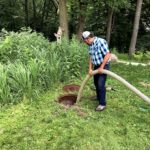In July we hired Brown Concrete and Backhoe to pump out Winding Pathways’ septic tank. We were surprised to hear Trevor Dickerson, who designs waste treatment systems and helped with our project, say that septic systems share similar characteristics with cars.
“If you don’t take good care of a car it might die when you are in the midst of traffic. If you don’t take care of your septic system it could fail just when the house is filled with wedding or graduation guests,” he said.
We weren’t having any problems with our septic system but it hadn’t been pumped for seven years. That’s getting long so we hired Brown to pump it out, inspect the system, and share tips on proper septic tank maintenance and care.
Few people give their septic system much thought – until it fails. They flush and forget. But, every day millions of bacteria and other organisms quietly consume waste in the tank and soil. They are biological wonders that help prevent water pollution.
- The septic system treats biodegradable materials
- Man pumping septic system
Most American homes are connected to a municipal sewer that channels waste into a treatment plant. All they need to do is pay a monthly or quarterly bill and not worry about a personal septic system. Folks living in rural areas aren’t as fortunate. They must have their own septic system to receive and treat waste. Proper maintenance reduces problems. Here are some actions we take to keep our system working properly.
- Only flush easily degradable items down the drain, such as human waste and shower and dishwashing water.
- Avoid putting anything toxic to bacteria down the drain. Bleach, antibiotics, paint thinner, and many other chemicals can kill the bacteria happily living in the tank, thus causing the system to fail.
- Consider food scraps, vegetable and fruit peelings, and other kitchen waste as valuable resources. They either go to our chickens or in our compost bin. Chickens convert food waste into delicious eggs and what they won’t eat becomes compost that nourishes our garden. We have a garbage disposal unit under the sink that we rarely use, as septic tank bacteria have a hard time digesting course vegetable matter.
- Spread out water use. Sometimes a septic system is overwhelmed if a homeowner does many loads of laundry in one morning, putting more soapy water into the system in a short time than it can handle. It’s better to schedule laundry tasks throughout the week.
- Have our tank regularly pumped. “Think of pumping a septic tank as similar to having the oil changed or doing a tune-up of the car. Regular maintenance reduces will extend the life of both,” explained Trevor Dickerson.
Every septic system is different because every family and yard is different. Our system works well because there are only two of us living in the home, we have flow restrictors on faucets and 1.6 gallons per flush toilets, and we’re careful to keep toxins out. We also live on the top of an ancient sand dune with steep topography. The soil in our yard readily absorbs water and the steep gradient allows gravity to channel waste quickly into and through our septic system.
Our system might fail if we had a very big family who flushed frequently. Here are some symptoms of a failing system:
- Water pooling on the ground.
- Odor.
- Slow drains and toilets backing up.
Call a septic tank specialist if symptoms show up.
Chemotherapy and Medications
Chemotherapy can result in an unexpected problem. These potent medications are highly toxic to the bacteria essential to septic tank operation. They vacate the human body in urine and feces and can kill bacteria and cause a septic system failure.
Coumadin and antibiotics can also cause problems. And people suffering from Bulimia also can pressure their septic system by discharging large amounts of partially digested food into the system. Trevor suggests that anyone taking chemotherapy medications monitor their septic system carefully and have it pumped more often than the average.
Additives
Many additives on the market can be flushed down a toilet and supposedly help the septic system work. According to Trevor, these won’t hurt but they may not help. Any active septic system is filled with bacteria and millions remain after pumping. They’ll quickly reproduce, so adding additional cultures won’t help. Think of a yogurt culture. Add milk to a tiny scrap of yogurt and bacteria quickly convert the new milk into yogurt. Adding more bacteria just won’t make any difference – but it also won’t hurt.
Adding bacteria to a new system devoid of bacteria or one that has had its bacteria killed may help speed up the treatment process.
Permits and Information
Our septic system was installed long before we bought the home at Winding Pathways, and we didn’t know its age or where the underground pipes were. Fortunately, we were able to get this information from our local county health department. It issues permits that are required to install a system and keeps records of systems in place. Permits are required everywhere but the agency that issues them varies from place to place. A good bet for a homeowner seeking information about a system is the local county office. Some municipalities or states may also issue permits. Browsing on the web will help locate area companies that install and maintain systems and usually, they are a wealth of information. We used Brown Concrete and Backhoe.
We’re fortunate at Winding Pathways. Our yard is large and our soil sandy. We also have steep topography. Combined, these help create an effective septic system that drains well. We planted prairie over our drain field. Roots extend up to 15 feet into the ground. They capture water oozing out of our drain field and convert it into lush vegetation and delightful wildflowers. So, even our toilet waste helps create a colorful wildlife haven.




Thanks for pointing out that you should have your septic tank regularly pumped because it will help extend the life of your septic system. My husband and I are trying to figure out how to best take care of our septic tank because we’ve never had one before and we want to make sure that it stays in good condition and works well. I think that it would be smart to schedule regular septic services so that we can make sure it will continue to work well and will get the pumping and maintenance that it needs.
Thanks, Steele. Check with a reliable septic service in your area for guidelines.
… and don’t plant trees in the septic field!! (At least that’s what I’ve always been told.. that’s correct, right) I loved spending time wid y’all!
You are right Paula. In general, trees and septics do not go well together. You can look on-line for the guidelines for planting trees and proximity to septic fields.
It’s good to know that pumping your septic tank frequently will extend its lifetime. Now that my wife and I just had our septic system installed, we would like to know how often it should be cleaned so that we don’t need to worry about paying for repairs. I think that having our system regularly pumped will guarantee that it will last for a long time.
Thank you, Stefan. We have found that taking good and regular care of any appliance, system, household….benefits in the long run. Look for our blog on roofing coming this week. M~
I love that you explained how you can prolong the lifespan of your septic system by having it routinely pumped. My brother has recently mentioned that parts of his lawn are starting to grow quicker than the rest, and he is worried that his septic system may be overflowing since he has failed to maintain it. Maybe he should find a professional that will pump his system.
It sounds like you are on this! Let us know how things work out.
My dad has noticed that there has been water pooling in his septic tank’s drain field recently, and we are trying to figure out what the problem is. Thanks for mentioning that if you see that or have slow drains and toilets backing up, it’s best to call a professional to come take a look. I’ll have to tell him to do that so that he can get it repaired sooner rather than later to help prevent the problem from becoming worse.
We are happy our information helped you. Thanks, Michaela!
Thank you for mentioning how doing too much laundry in a day can strain your septic system since it can only handle a limited amount of soapy water. Whenever my wife does laundry after work, I notice that our lawn becomes soggy which makes me worry that our septic system may be releasing excess water. It may be best for me to have my septic system cleaned in order to avoid serious damages.
Derek: Yes, maintenance on any household item or system is important before problems pop up. Consider checking with a reputable septic company in your area for the recommended time span to clean a system. Good luck! M~